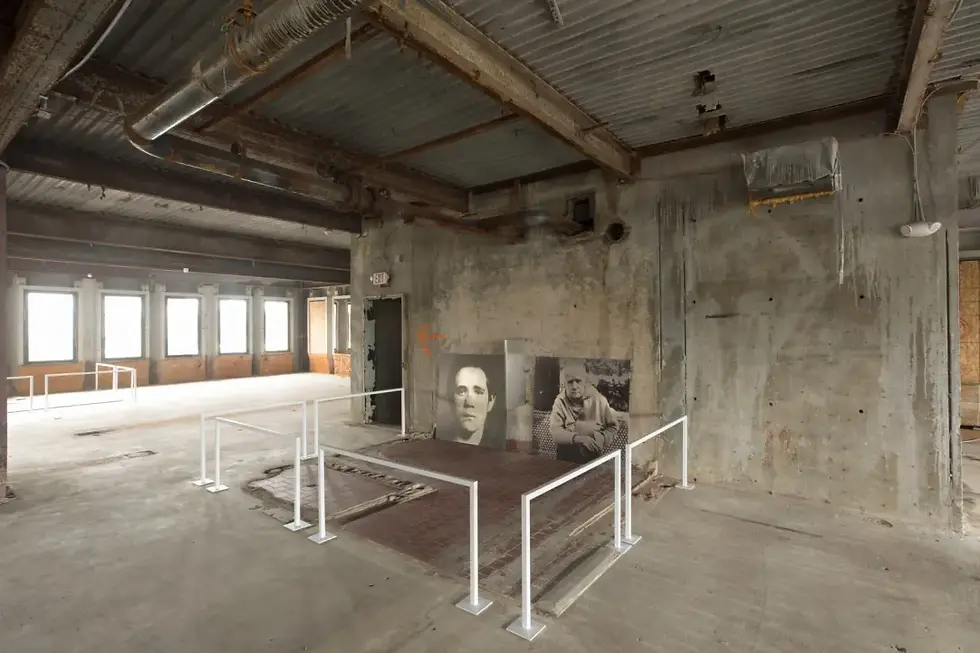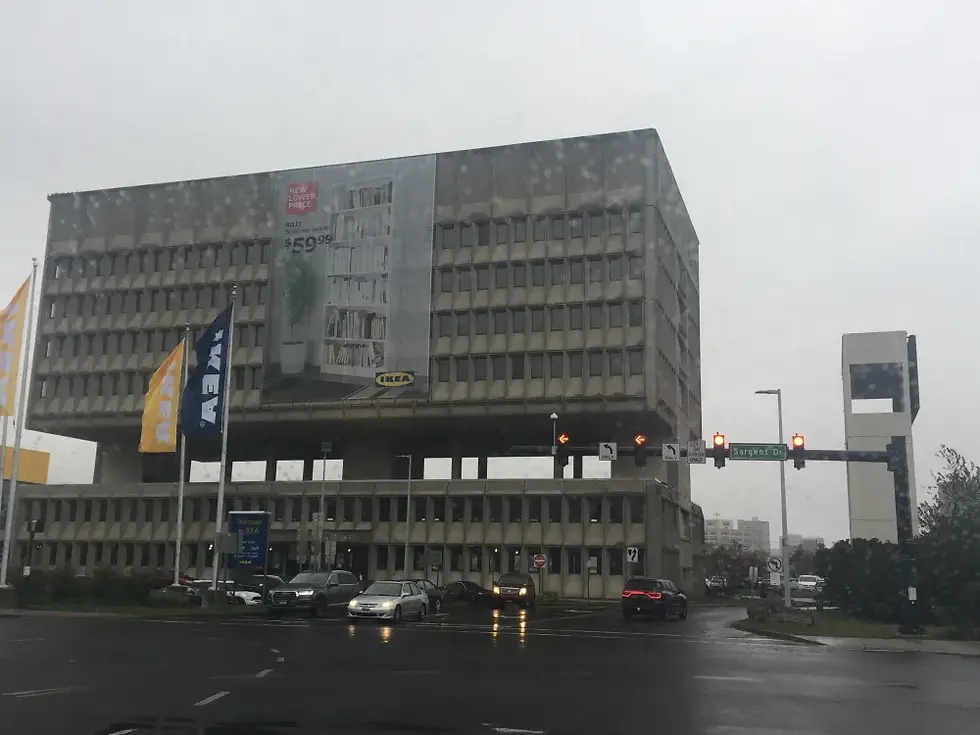New Haven: Tom Burr revives Jean Genet’s ‘May Day Speech’ at Yale/ the Pirelli bldg
- Venetia Kapernekas

- Jan 11, 2018
- 8 min read
Updated: 6 days ago

“What is still called American dynamism is an endless trembling.”
Jean Genet’s prophetic declaration, written for a speech he delivered on May 1, 1970 at Yale University, before an audience of approximately 25,000 (published in Hyperallergic, Tim Keane, Jan 21,2017
Reflecting last days of our ‘contemporary political landscape’, I recall that rainy Sunday morning, November 5th, invited by Stefania Bortolami for a journey to New Heaven as of the last day of a ambitious project by artist Tom Burr, part of the expanding out of the box /Bortolami gallery projects “Artist/City”. Over the past six months, Tom Burr has occupied and activated the first of the Marcel Breuer-designed Armstrong Rubber Company, later and more colloquially known as the “Pirelli Building” for the Pirelli Tire Company.After extensive demolition and remediation to the lobby’s original interiors, local codes required new railings. Burr produced and engraved new stainless steel railings with the complete text of Jean Genet’s “May Day Speech” delivered at Yale on the occasion of the 1970 May Day Rally (shortly after the construction of the building) in support of the Black Panthers, and their recently imprisoned founder, Bobby Seale. Burr named this site-responsive sculptural work The Railings (May 1970). (gallery press)

In order to open the Pirelli Building to the public, the City of New Haven required the artist and the gallery to cordon off the rough edges of its naked interior with safety railings; this became the most and central piece for Burr as he inscribed with Genet’s speech, in full. Genet’s words may ring true today: ‘We whites are living perhaps in a liberal democracy, but the black lives, like it or not, under a paternalistic, authoritarian, imperialistic regime.’

Genet was legendary for his queer subversion of power and his fetish for domination; his face appears twice in the Pirelli Building’s open-plan ground, printed on aluminum plates. Photographs of young and old Genet (Bae Genet / Grey Genet, all works 2017) rest on either side of a urinal divider, separated – or perhaps conjoined by – decades of sexual deviance.

“Located in the artist’s hometown, the Breuer- designed building constitutes a cipher for the various social and political concerns central to Burr’s work, not to mention the artist’s own autobiography. As he explains, “I was born there a handful of years before the Pirelli Building was built, so it was always in my mind while I was growing up.” Armstrong Rubber commissioned the building in 1968 for its factory and executive offices and it became an iconic emblem as the entrance to the city o Interstate 95, particularly at a time when the city was gaining attention for its urban renewal and restructuring. The building was envisioned and constructed as a symbol of utopian urban strategy but, like many examples of Brutalism became a representation of the failure of Modernism’s idealistic aspirations.” (Bortolami gallery,NY, press text)

This Brutalist masterpiece has served as the site of an evolving exhibition that commenced with the first phase, Pre-Existing Conditions, and it concluded with the final phase, “Always Already Happening”, an ongoing durational performance consisting of simultaneous readings throughout the space …..
Tom Burr during the last day of the Artist/City project, (November 5,2017) orchestrated a four-hour performance at the ground floor; a group of “actors” /Yale are students were reading texts by or responding to the legacy of Anni Albers, Jean Genet, and the Black Panthers; the actors were positioned near “zones of intensity” and each person was reading a specific text during the 4 hour duration.


Yale Art students hired by Tom Burr reciting text (4-hour performance/Nov 5, 2017)photo @VKThe interior space had no heating and the constant rain and greyness of the day o had created a heavy atmosphere within the dry and gloomy colors inside; while the actors /students were reading, I found it somehow refreshing to take snippets of the text mirroring the experience of reading The Railing (May 1970)

Located in the artist’s hometown, the Breuer- designed building constitutes a cipher for the various social and political concerns central to Burr’s work, not to mention the artist’s own autobiography. As he explains, “I was born there a handful of years before the Pirelli Building was built, so it was always in my mind while I was growing up.” Armstrong Rubber commissioned the building in 1968 for its factory and executive o ces and it became an iconic emblem as the entrance to the city o Interstate 95, particularly at a time when the city was gaining attention for its urban renewal and restructuring. The building was envisioned and constructed as a symbol of utopian urban strategy but, like many examples of Brutalism, became a representation of the failure of Modernism’s idealistic aspirations. (gallery press text)

Burr’s sculptural composition entitled Women Who Work consists of a group of IKEA chairs facing away from a printed aluminum panel featuring a textile design by Joseph Albers. Burr positioned a book called “Women’s Work: Textile Art from the Bauhaus” is open on one of the empty chairs, suggesting maybe an absent audience.

Next to two bathroom doors, one labeled “Gentlemen” and the other without any label, Burr positioned a portrait of J. Edgar Hoover brandishing a gun. At that time Hoover presiding FBI Director in 1970 he ordered his agents to disrupt and discredit radical groups, like the Black Panthers who were on trial in New Haven at the time.
Best known as the home of Yale, one of the most elite universities in the US, New Haven is a surprisingly blue-collar port town. Tom Burr was born in New Haven in 1963, under the mayoralty of Dick Lee, a prodigious builder and an enthusiast of modernism. In 1968, Lee convinced the Armstrong Rubber Company to hire Marcel Breuer to design their corporate headquarters: an imposing seven-story concrete tower atop a long base, like a head on a recumbent body. Armstrong was bought by Pirelli, a tire manufacturer, who later sold the building to IKEA; after demolishing its base, though, the Swedish megastore decided to set up shop next door, leaving the stripped Breuer behemoth abandoned for over 15 years. (text from gallery press)

“Genet’s highly stylized, sexually explicit works in memoir, fiction and playwriting transformed each of those genres, scandalizing readers and audiences and turning him into one of the most exasperating and profound moralists of the twentieth century. Late in his career, facing a decade-long writer’s block, his writing was reborn, first by engaging with the visual art and later, through writing about aspiring revolutionary groups who were fighting power from the margins. Little wonder, then, that by the late 1960s he was drawn to the trembling that was shaking the United States.” (Tim Keane, Hyperallergic, January 21, 2017)

The speech, read in its English translation by a founding Black Panther member, Elbert “Big Man” Howard, consists of a rousing appeal on behalf of Bobby Seale, who was then on trial in New Haven for murder (the charges were eventually dropped). Genet’s oratorical strategy, a full-scale assault on the toxic apathy of white liberals, remains prophetic.
Genet blames the prevalence of racism on his Yale audience. “It is very clear that white radicals owe it to themselves,” he declares, “to behave in ways that would tend to erase their privileges.” Closing on a provocative note, he further goads the audience by comparing universities to “comfortable aquariums […] where people raise goldfish capable of nothing more than blowing bubbles.” Reread in light of the response to controversial police killings of African Americans in Charlotte, Ferguson, and elsewhere, Genet’s words bluntly spell out the diplomatically stated ideas coursing through the Black Lives Matter movement. (Harriet Staff, ‘A Look at Jean Genet’s 1970 May Day Speech,published at Poetry Foundation, January 23, 2017)

‘……The Frenchman’s name was Jean Genet, but I had no idea what that meant. David gave me a slender book, entitled The Blacks, with the name Jean Genet listed as its playwright.I turned to the back cover to learn more. It described the play, The Blacks, as an example of what was called ‘The Theatre of the Absurd’ (Mumia Abu-Jamal, Blogcitylights, September 9, 2016)
I want to thank Tom Burr and Stefania Bortolami, an amazing visionary gallerist, who gave me the chance to travel thru time, challenge and question myself where we are now as viewers, as spectators, as life critics, as young in heart revolutionary students, as mothers, being concerned of our times and the political fearful environment. My early student days in Berkeley was after Genet and Angela Davis ‘s teaching days while their speeches were ‘rocking’ the strong temples of the University. Indeed, their echo was still there; it also spread thru the Pirelli building that morning thru Burr’s selection of performance texts by the students and his fabulous rail installation/art piece.
“The essence of theatre is the need to create not merely signs,” Genet writes, “but complete and compact images masking a reality that may consist in absence of being.”

So much of my specificity as an author, as an artist, has to do with being a queer subject. …I became interested in throwing these things into the foreground, not letting them exist in an anonymous vessel. I’m interested in this project being a culmination of these facets, these problems/masquerades/privileges/disappointments, of both this particular building and my own body. All of these conditions that operate both metaphorically and actually, manifest in the presence of the building and in the hopes and dreams and expectations and all the disappointments and abandonments as well. … (Tom Burr, as told to Julian Elias Bronner, Artforum,500 Words, Feb 3, 2017.online)

“I don’t have a preservationist approach to my project,” says the artist. “I like the building, so I don’t want to see it taken down. But I’m not here to save it. I’m interested in the fact that it’s amputated.” (Tom Burr to Mark Byrnes at CityLab, Oct.5, 2017





